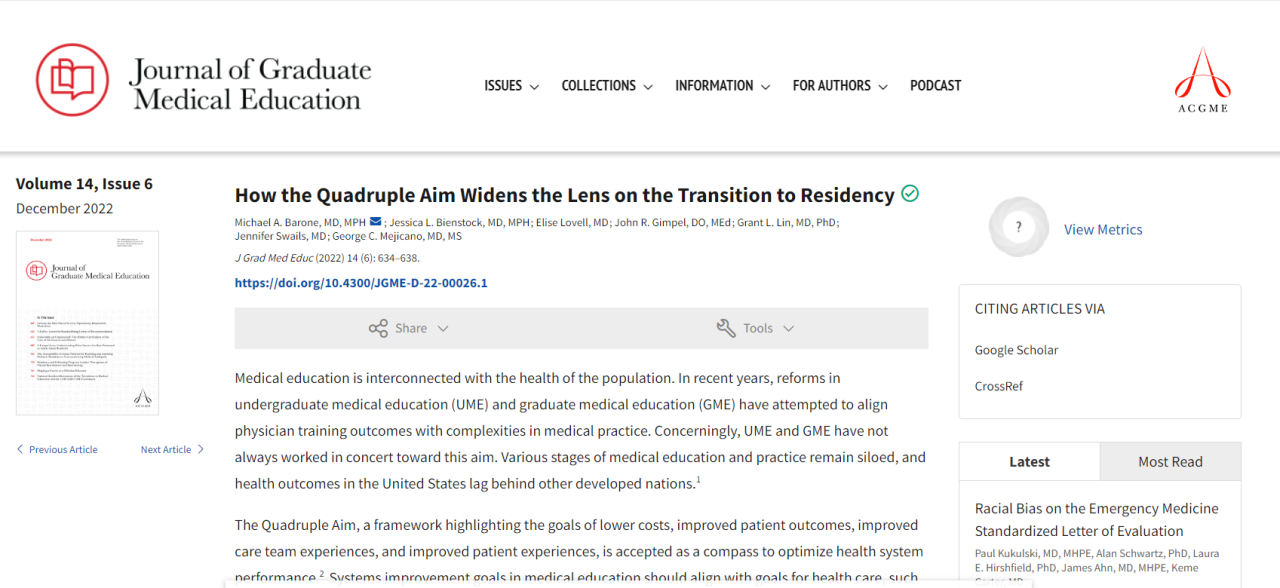The NBOME joined the Coalition for Physician Accountability’s Undergraduate Medical Education (UME) to Graduate Medical Education (GME) Transition Review Committee (UGRC) in 2020 to focus on improvements to the current state of transitioning from medical school into residency.
Today, members of the UGRC—including NBOME President and CEO John R. Gimpel, DO, MEd—co-authored an article in the Journal of Graduate Medical Education that expands on the committee’s 34 recommendations originally published in August 2021.
The article, “How the Quadruple Aim Widens the Lens on Transition to Residency,” explores some of the UGRC’s recommendations within the framework of the Quadruple Aim of healthcare: lower costs, improved patient outcomes, improved care team experience, and improved patient experience.
Several of the UGRC’s recommendations dovetail with the Quadruple Aim by addressing issues related to providing trustworthy and accurate advising resources for applicants; mitigating structural biases in the residency application process; and creating competency standards that more directly relate to improved patient experiences.
The article also notes a fifth potential aim: equity, which aligns with the URGRC’s recommendations related to diversity, equity, and inclusion, as well as those promoting the equitable treatment of applicants.
The authors note, “Recommendations focused on equity are aimed at mitigating structural biases toward underrepresented in medicine applicants as well as international and osteopathic applicants, many of whom struggle with belonging. Residency program directors are in the unique position of training the next generation of physicians and advancing the health of the public through the development of a sustainable, diverse, and competent workforce.”
DO students report sometimes experiencing bias and lack of familiarity with their educational pathway, degree designation, or even on the basis of their licensing examination.
“I believe most residency program directors (PDs) understand the distinctive osteopathic pathway and the value that interviewing and matching DO applicants brings into their program,” said Gimpel. “Most PDs understand that COMLEX-USA is the licensure exam for DOs, is accepted in all 50 states and other U.S. jurisdictions, and is taken by 100 percent of DO students. Many also know that COMLEX is easy to use in the ERAS system as part of a holistic review of DO residency applicants, and most are using COMLEX for DOs.
“It is our hope that those who are not will eliminate the biased and archaic practice of asking DO applicants for USMLE results,” he added.
Authors implore decision-makers across the UME to GME transition to consider the UGRC’s recommendations not only as a way to improve the transition to residency for applicants, faculty, and staff but as a way to improve the health and wellbeing of patients. They state that implementing those recommendations will ensure a stronger, more diverse workforce, which will ultimately contribute to better patient care and patient outcomes.
Along with the NBOME, the paper’s authors represent a number of prestigious academic institutions across the house of medicine, including Johns Hopkins University School of Medicine, Stanford University, the University of Texas Health Sciences Center/McGovern Medical School, the University of Illinois, and the National Board of Medical Examiners (NBME).
Fellow members of the UGRC include the American Medical Association (AMA), the American Osteopathic Association (AOA), the Educational Commission for Foreign Medical Graduates (ECFMG), the Association of American Medical Colleges (AAMC) and the American Association of Colleges of Osteopathic Medicine (AACOM), and the NBME.

